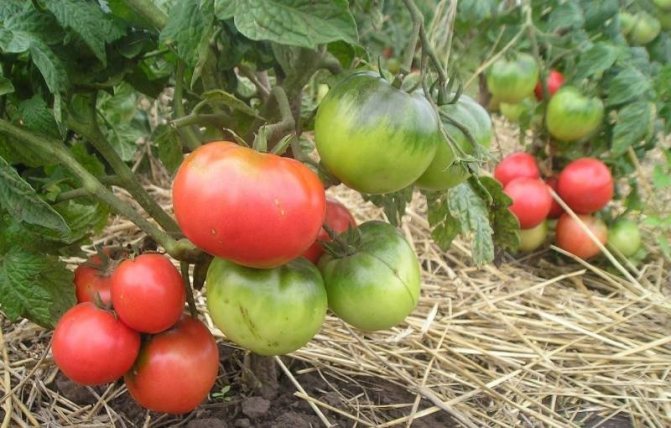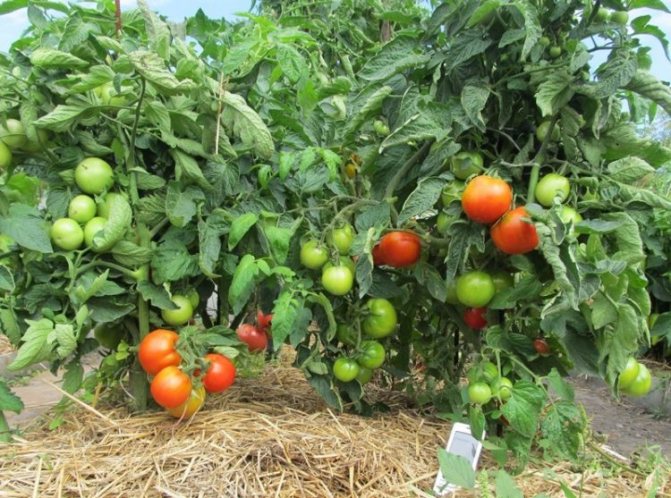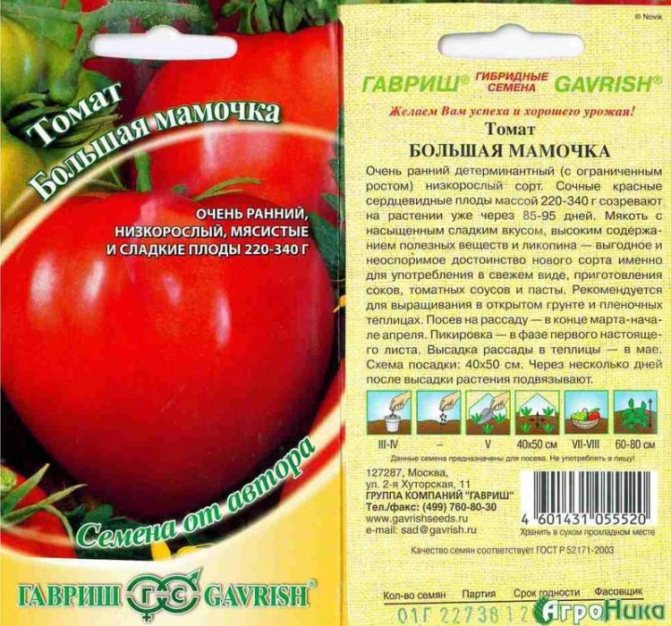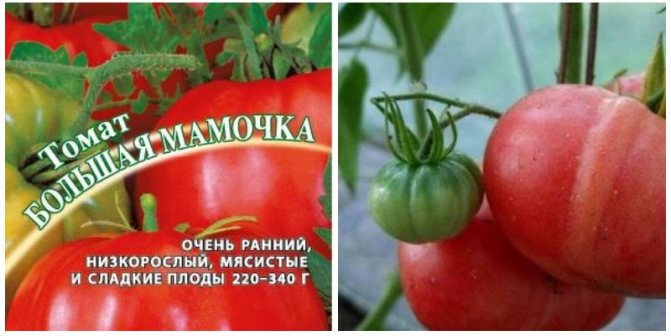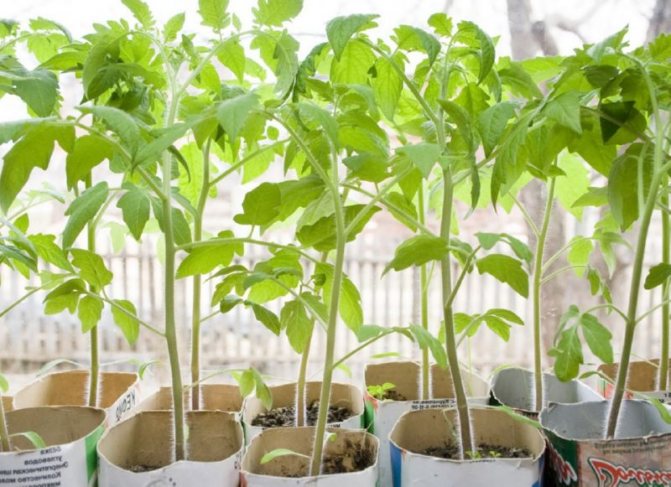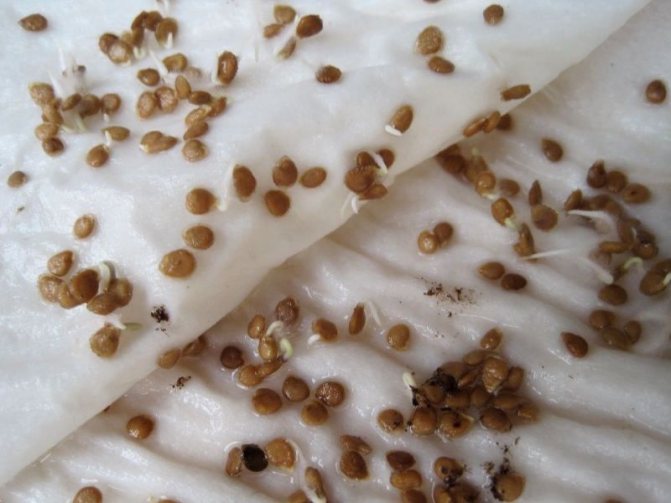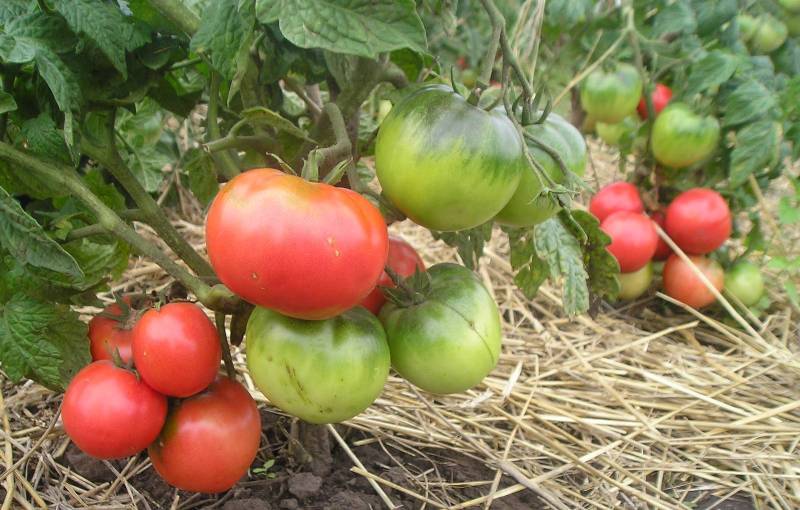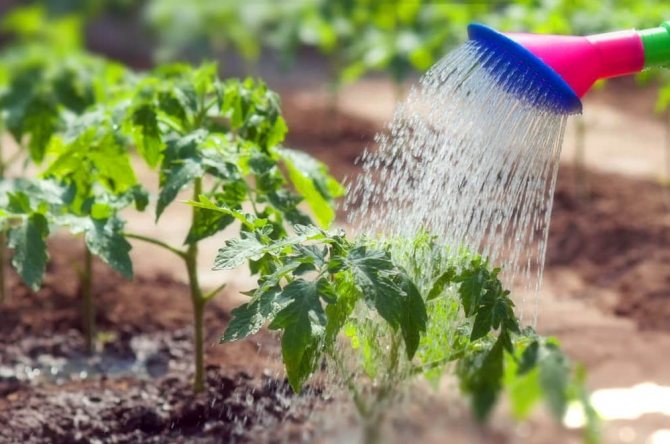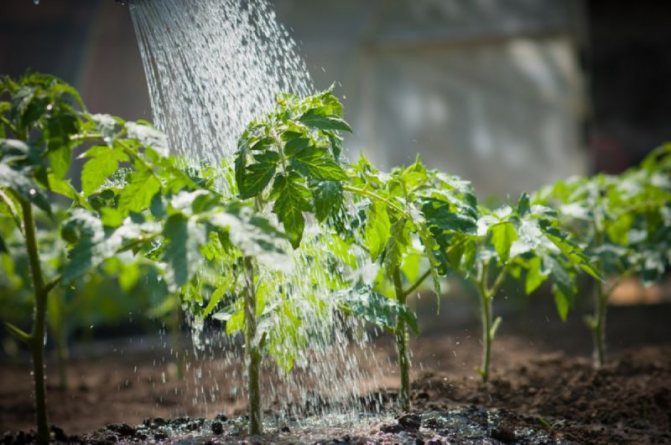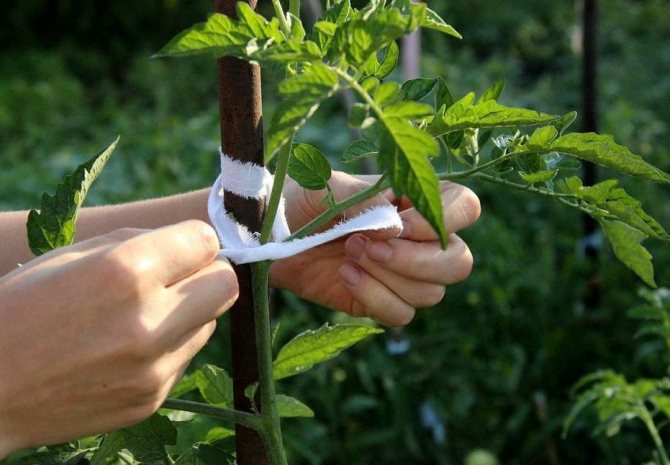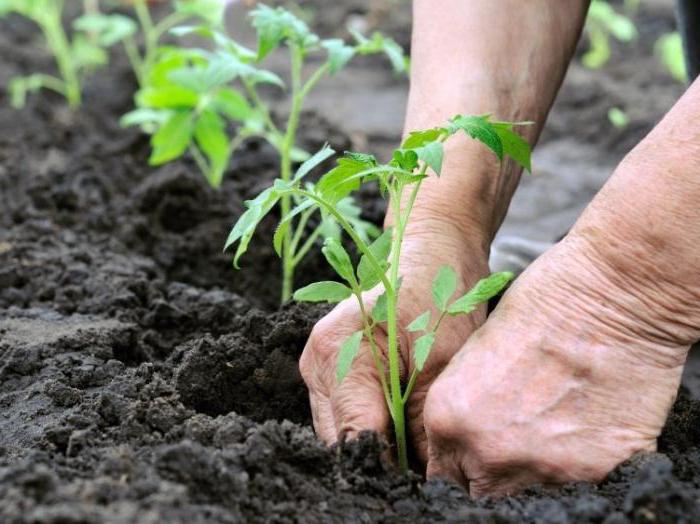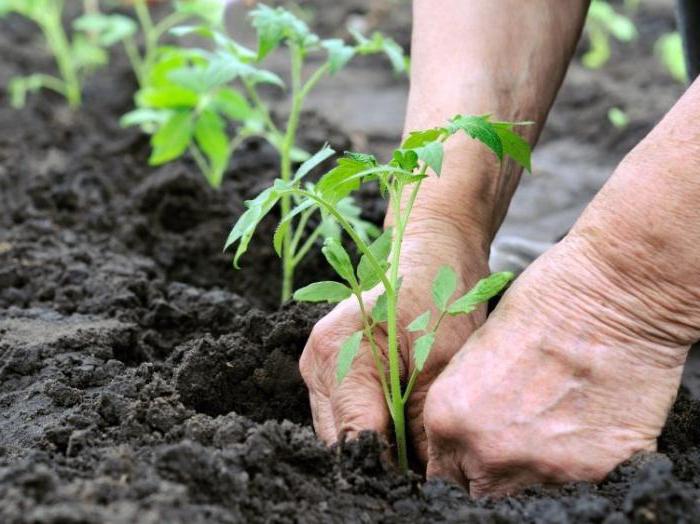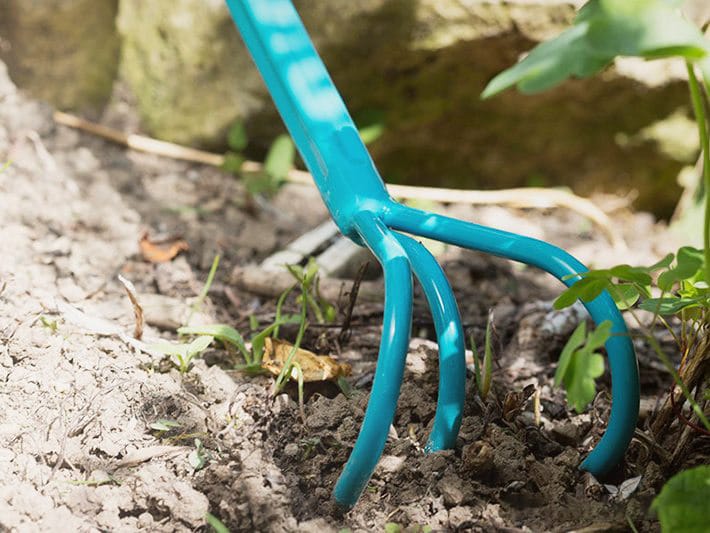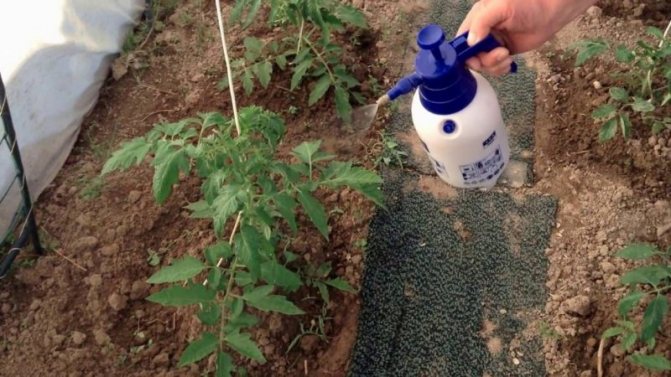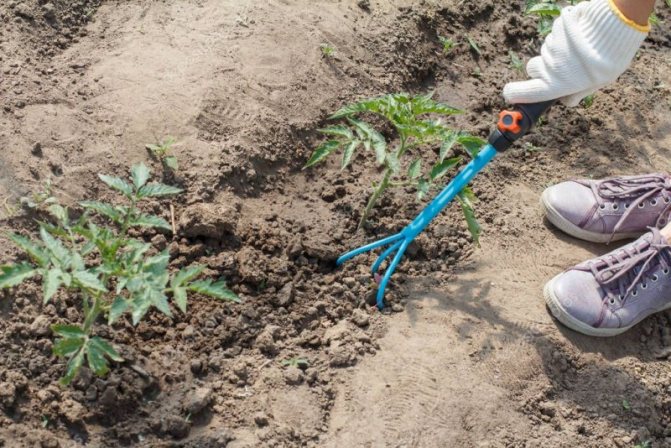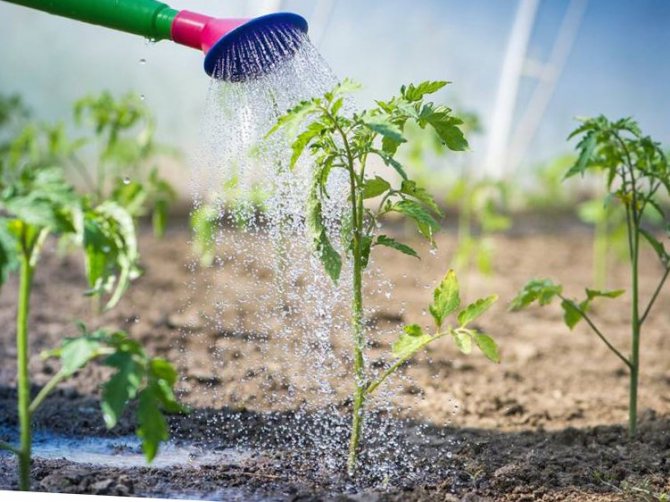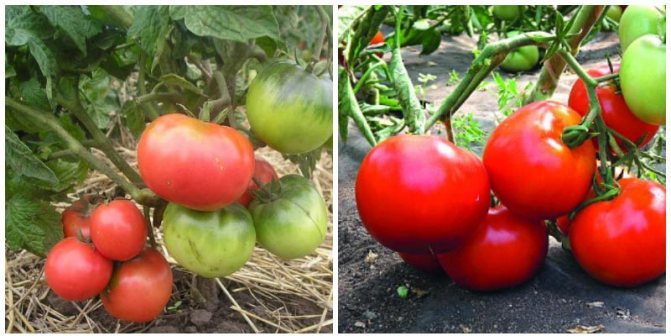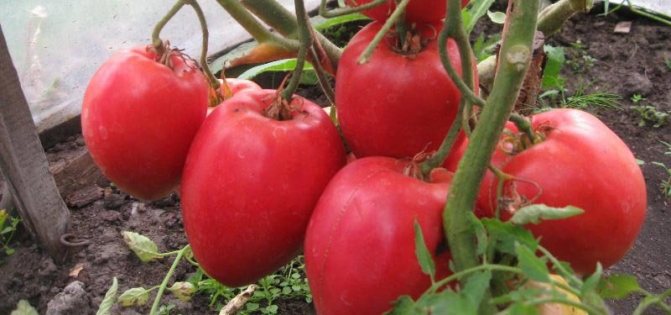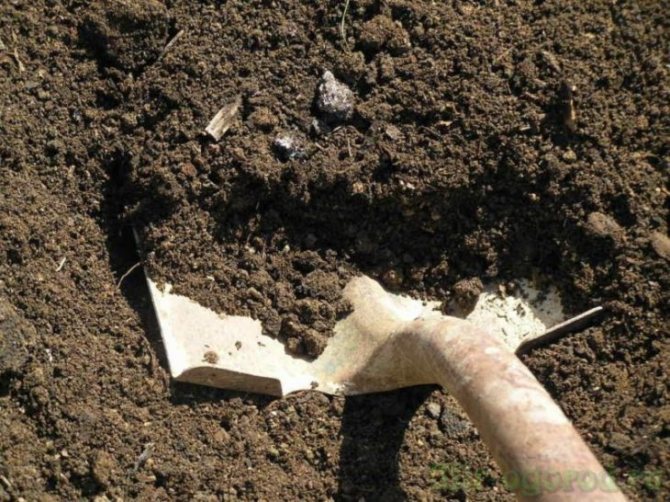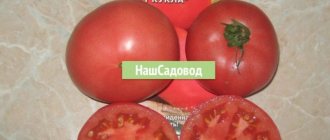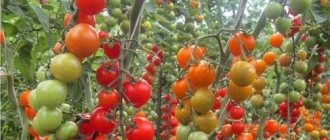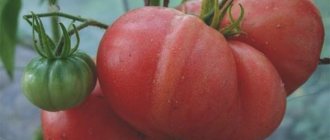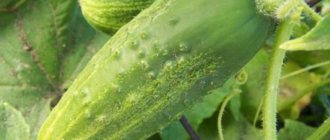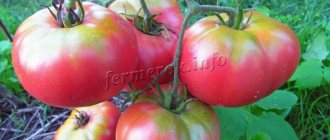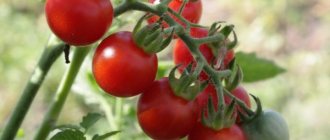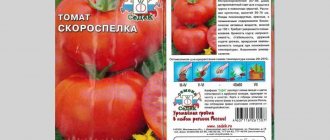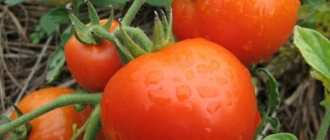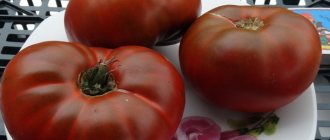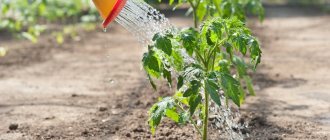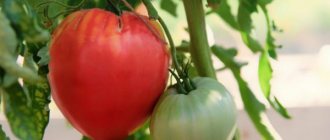Author rating
The author of the article
Yakov Pavlovich
Professor, Head of the Department of Vegetable Growing
Articles written
153
The work of domestic breeders is a pleasant surprise. They continue to develop more and more improved varieties of tomatoes. Big Mom is a relatively new variety for vegetable lovers. It gained its popularity due to the excellent taste of the fruit. Growing and caring for it will not take much time and effort. Next, consider the characteristics and description of the Big Mom variety.
Description of the variety
The variety was entered into the State Register of the Russian Federation four years ago - in 2020. The originator was the Russian one, formed in 1993. The enterprise has 5 breeding centers in Moscow, Tula regions, Krasnodar Territory and the Kingdom of Jordan.
Big Mom is recommended for growing in all climatic zones in open ground and film shelters.
Distinctive features
Determinate early variety. The height of the bush is 60 cm. The stem is strong, the leaves are medium-sized, wrinkled, light green, not pubescent, potato-shaped. They do not grow abundantly on the bush. The roots grow wide. The first inflorescence appears after the fifth pair of leaves, each with up to six ovaries.
The articulated sturdy stalk is capable of withstanding heavy fruits. From the appearance of the first shoots to the ripening of tomatoes, 85 days pass.
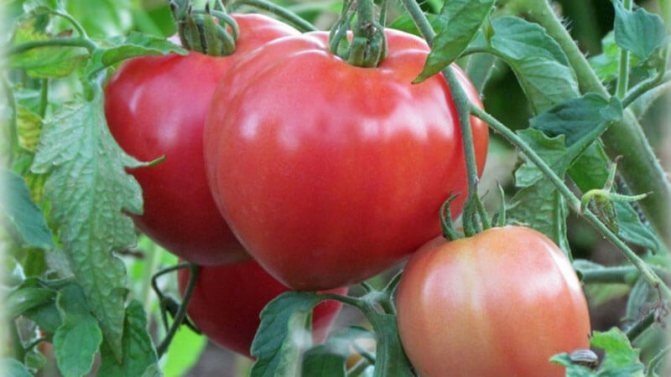
Fruit characteristics and yield
Tomatoes are rounded, slightly ribbed, with a small nose, shaped like a heart. The skin is bright red, dense, smooth, thin. Fleshy, juicy, sugar pulp has a small number of seeds. The taste of tomatoes is rich, sweet, with a pleasant tomato sourness. The weight of one fruit is 200-350 g.
The yield of the variety is up to 9 kg per 1 sq. m (6 bushes).
Nuances of agricultural technology
In warm, southern regions, you can grow Big Mommy outdoors, in colder areas, it is better to choose a greenhouse or film shelter. The rest of the care is very very simple and consists of several nuances:
- Timely and not too abundant watering. It is worth focusing on the ground around - it should be a little wet, but in no case wet, and even more so without puddles.
- Garter. For some reason, there is an opinion that it is not necessary to tie up low tomatoes, but this is not so. Big Mom needs a competent garter and solid support.
- Bush formation. Usually, the cultivar itself produces five shoots. But experience shows that you will get the largest and best harvest when you form a bush with two or three shoots.
- The variety needs periodic feeding during the most difficult periods for growth - that is, at the time of flowering, active growth of the crop and after harvest.
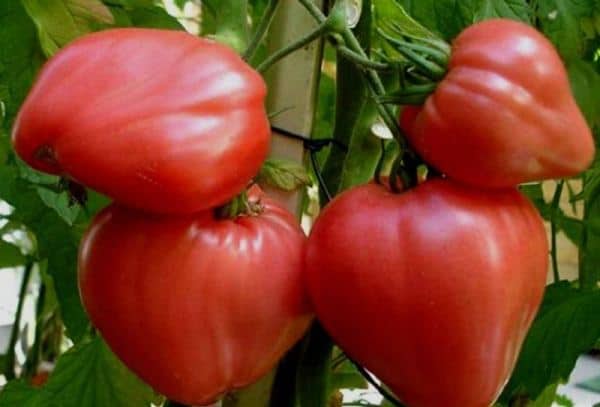

How to grow seedlings
Seeds for seedlings are sown 55-60 days before planting in the beds. For greenhouses - in mid-March, for open ground - in early April.
Seed preparation
A month before the start of agrotechnical work, the preparation of seed material begins. Experienced farmers recommend preparing seeds in seven stages.
Calibration
The seeds are poured out of the bag and carefully examined. Small, uneven, empty to the touch seeds are thrown away, and medium / large, even seeds are placed in a saline solution. To prepare it, dissolve a tablespoon of salt in a glass of water.
After 20 minutes, the seeds floating on the surface are caught and thrown out - the likelihood that they will sprout and give a crop is low. The seeds that have sunk to the bottom are washed with water and dried.
Warming up
The seed is placed in cotton bags, which are hung on the heating battery for 10-12 days. Fast way: seeds on a cotton cloth are placed on a central heating radiator. The duration of warming up is 36-48 hours.
Disinfection
The heated seeds are disinfected with a 1% solution of potassium permanganate (1 g of potassium permanganate is added to 100 ml of water). The procedure is carried out for 15-20 minutes.
Bubbling
The grains are placed in warm (+ 26 ... + 30 ° C) water, an aquarium compressor is connected (or the water is intensively stirred every hour with a spoon). This saturates the seeds with oxygen, which improves germination and seedling growth. The duration of the procedure is 15-18 hours.
Soak
Seed material is poured with warm water (+ 21 ... + 26 ° C) or a solution of biostimulating drugs. With water - for 12 hours, and the drugs are used according to the instructions on the package.
Popular among farmers:
- "Zircon".
- Epin.
- "Immunocytophyte".
Advice. Summer residents recommend "honey soaking". To do this, dissolve 10 g (teaspoon) of honey in a glass of cool water. The grains are laid out on a cloth or gauze, 3-5 teaspoons of the solution are poured and the cloth is wrapped in an envelope. Soaking is carried out for 3-12 hours, as the material dries, it is moistened with a solution.
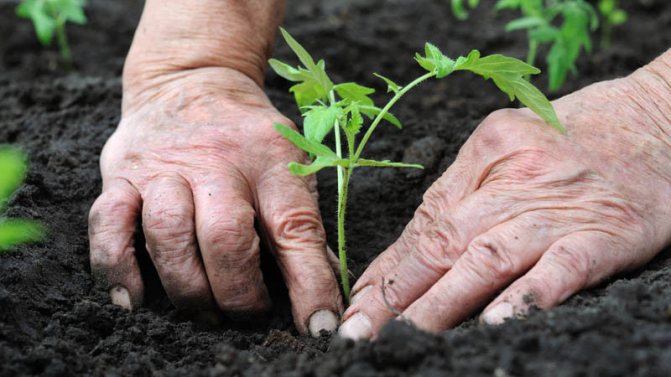

Hardening
Having wrapped the seeds in cloth and polyethylene, they are placed in a cool place with a temperature of +2 to -3 ° C for 8 hours (refrigerator, balcony, summer veranda). After - for 8 hours in a room with room temperature. The change of temperature conditions is repeated 5-6 times.
Experienced gardeners do not recommend that beginners harden all planting material, because if the procedure is performed incorrectly, there is a high risk of spoiling the seeds.
Germination
The grains are wrapped in gauze or cotton cloth, placed on a flat dish (lid, saucer, Petri dish). The fabric is regularly moistened with warm water (+ 25 ... +30 ° C) until embryos of 2-3 mm in size appear.
Capacity and soil
For Big Mom, choose a versatile potting soil that is available in abundance in stores.
It includes:
- humus;
- peat;
- river sand.
For self-production of soil mixtures take:
- one part of the land from the garden (from the site where cucumbers, zucchini, carrots, dill grew);
- two parts of non-acidic peat (pH 6.5);
- 0.5 parts of sand (river or washed);
- one part of humus or sifted mature compost;
- some wood ash (dolomite flour), sphagnum moss and fallen needles.
As a container for seedlings, plastic cups, cut bottles or cardboard packaging from dairy products, juices, special containers are suitable. Before use, they are washed with a weak solution of potassium permanganate.
Sowing
The soil is laid out in containers, shallow (1-2 cm) grooves are made, where the seeds are placed. Grains are added dropwise, the soil is watered with warm, settled water using a spoon, syringe or spray bottle. The containers are covered with plastic wrap and placed in a warm, bright place.
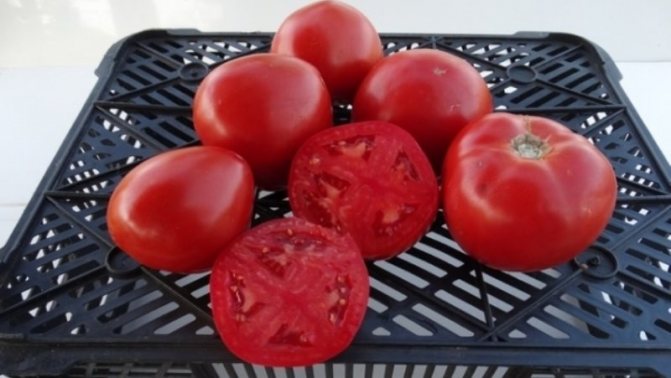

Growing and care
As soon as the seeds sprout, the film is removed.
From the author. This year I tried to plant tomatoes of this variety. Seedlings hatched on the third day after planting. They sprout together, grow quickly.
The sprouts are watered as the soil dries up, being careful not to wet the stem and leaves.
After a pair of true leaves appear on the plants, the seedlings dive into separate containers. Containers are chosen with a volume of at least 300 ml.
Important! When transplanting seedlings, the central root is shortened by 1-1.5 cm.This will allow the roots to grow wide.
Seedlings are fertilized every 14 days, alternating mineral and complex fertilizing. The first complex feeding is applied 10 days after the pick.
Big Mom is a light-loving tomato, therefore, after a pick, the plants should receive light for 12 hours. If the region has a short daylight hours, the seedlings are supplemented with fluorescent or LED lamps, which are placed strictly above the plantings.
At the age of 45 days, the seedlings begin to harden, taking them outside for 3-4 hours in the shade. Every day, they increase the time spent on the street by 1 hour and gradually accustom the plant to sunlight. A day or two before planting in the ground, the seedlings are left to spend the night in the open air.
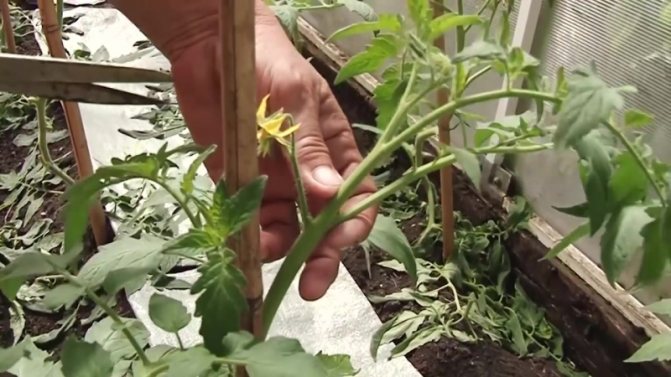

Diseases and pests
Tomatoes of this variety are resistant to many diseases. But under unfavorable circumstances and non-observance of the rules of agricultural technology, diseases and pests may appear.
Let's consider the main ones:
- Late blight. Its appearance can be triggered by temperature drops, heavy rains and increased moisture. Late blight affects leaves and fruits - dark brown spots are formed on them. Chemicals containing copper (Bordeaux liquid) cope with this disease perfectly.
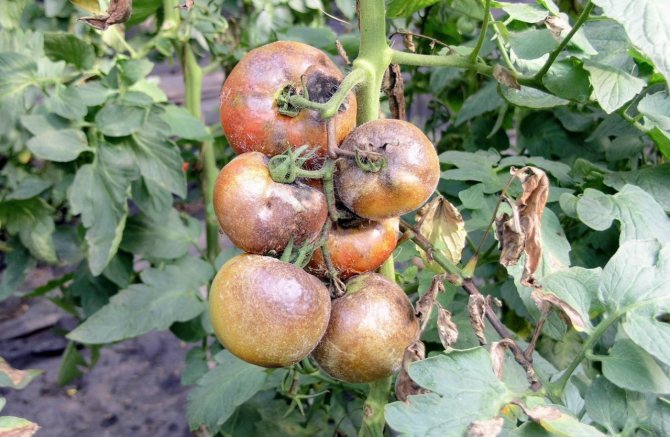

- Gray rot. The reason for the appearance is a lack of calcium and excess moisture. Gray rot is identified by dark spots on the fruit. For the fight, it is recommended to use calcium nitrate.
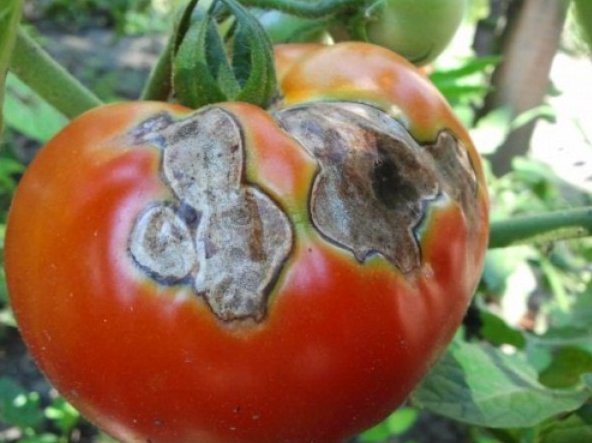

- Medvedka. He loves manured soils and, in order to get rid of it, they try not to bring raw manure into the ground or make manure traps out of it. Chemicals are often used, for example "Thunder", "Bankol".
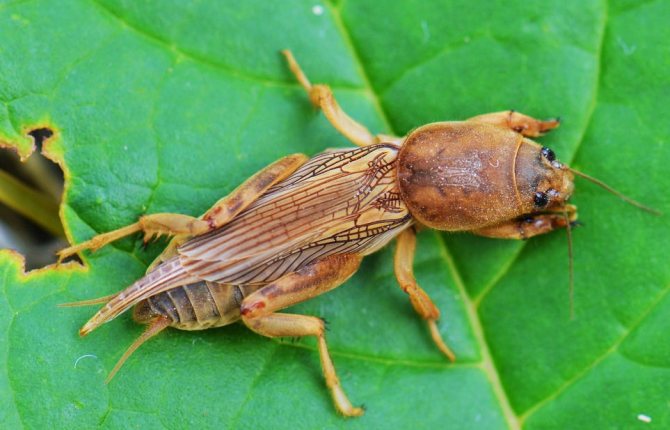

- Wireworm. Use the drug "Bazudin" by placing its mixture with sand in the wells.
- Scoop. The caterpillars of this moth are sprayed with chemicals (Decis, Aktara) or garlic infusion.
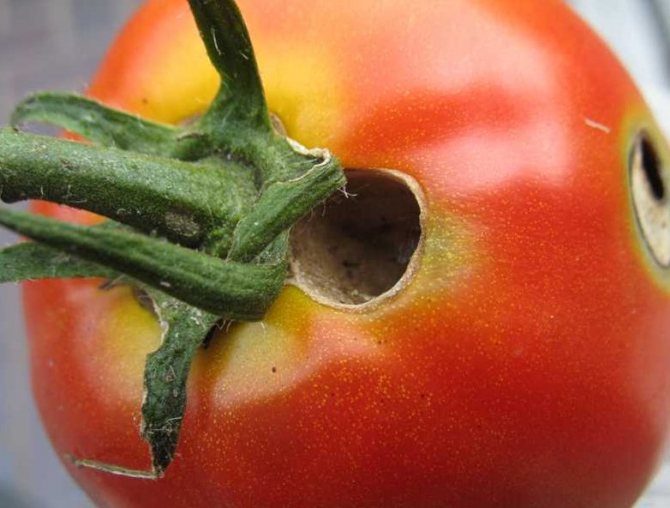

- Whitefly. Usually lives in greenhouses. For these small white butterflies and their larvae, the same remedies will work as for scoops.
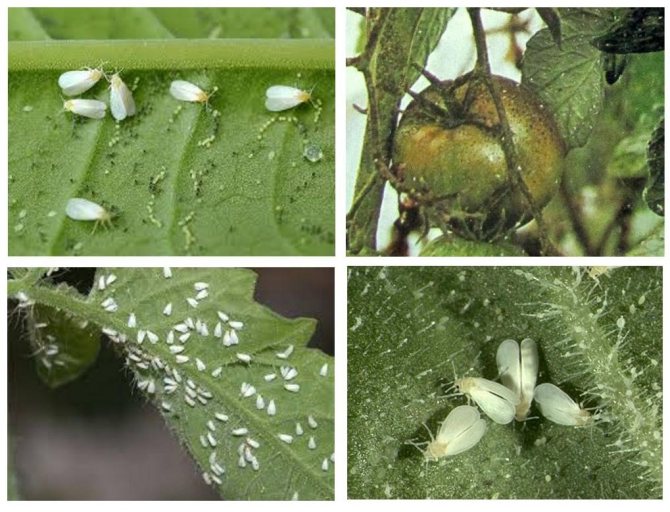

Tomatoes can be attacked by other insect pests - mites, slugs. In this case, you can use folk methods of struggle or apply chemicals. To prevent the appearance of diseases and pests, it is necessary:
- remove weeds from the site;
- carry out regular loosening of the soil, as well as mulch it;
- water according to all the rules in the morning or evening;
- digging the soil in the fall;
- to destroy the tops of "worn out" tomatoes;
- to make plant feeding with organic and mineral fertilizers;
- adhere to the correct crop rotation;
- carry out preventive spraying with chemical and folk remedies.
Did you know? The aroma of marigolds, calendula, mint, garlic planted near the site with tomatoes will scare away many pests.
Tomatoes of the Big Mommy variety have a high yield and form a lot of universal fruits. Although they have a determinant bush, it must be tied up and pinned, forming 2-3 stems. But the variety is appreciated for its resistance to late blight and other diseases of tomatoes.
How to grow tomatoes
Seedlings are transplanted to a permanent place at the age of 55-60 days. In cold regions - only in film shelters. The soil temperature should reach + 13 ... + 15 ° C, and the air temperature - + 12 ° C and at least + 5 ° C. Frosts will either destroy immature plants, or slow down the development of tomatoes for 15-20 days.
Landing
The site for the future planting of tomatoes is selected in advance. It is important that plants of the Solanaceae family do not grow on it a year before, but cucumbers, zucchini, dill are good predecessors and neighbors for tomatoes of any kind.
The day before planting seedlings, the soil is disinfected with a strong solution of potassium permanganate or boiling water. For Big Mom, choose a planting scheme of 40 x 50 cm.
Care
Tomatoes are transplanted in a greenhouse in early to mid-May; in warm regions, it is permissible at the end of April.By this time, from five to nine pairs of leaves have already grown on the seedlings, and the growth of plants reaches 20-25 cm. Tomatoes of this variety are recommended to be planted in open ground only in warm regions of the country - a month later than under a shelter. In central Russia, when grown outside the greenhouse, it is advised to cover the tomatoes with agromaterial in the first 15-20 days.
A week after the transshipment, the bushes are tied up. Water as the soil dries up, strictly under the root, preventing moisture from entering the stem and leaves. Water for irrigation is pre-defended and heated in the sun. After each watering, the soil is loosened and weeds are removed. At the time of the formation of the fruits, the plants need abundant moisture in the soil, however, as soon as the green fruits begin to turn red, watering is reduced.
Fertilizers are applied every 10-12 days, alternating complex and mineral fertilizers. Before flowering, tomatoes are fed with nitrogen fertilizers, in the flowering phase - with potash fertilizers. Foliar dressing will help to increase the yield: wood ash, boric acid solution. After fertilization, the tomatoes are watered abundantly.
Gradually, the lower leaves are cut off from the bush so that they do not take useful substances from the ovaries and do not contribute to the spread of infections, harmful insects.
Bushes form 2-3 stems. The photo below shows the diagram: main escape + 1-2 stepson. The rest of the branches are removed. Stepson is carried out once a week, removing no more than two stepsons at a time. As the bush develops, each branch is tied up so that heavy fruits do not break and do not fill the plant to the ground.
Advice. Experienced summer residents advise removing a couple of unripe fruits from each inflorescence. In this case, those remaining on the branch will receive more nutrients and grow larger.


Features of cultivation and possible difficulties
As noted by farmers who have already tried to grow Big Mom tomatoes, there are no difficulties and peculiarities of growing this variety.
Diseases and pests
On the packaging, manufacturers indicate that tomatoes are highly resistant to fungal diseases and pests.
For the prevention and treatment of fungal diseases, plantings are treated with "Fitosporin". Brown olive spot (cladosporiosis) is treated with copper preparations, for example, "Bordeaux mixture" or "Zaslon", top rot - by spraying with calcium nitrate.
Advice. In regions with short, cool or rainy summers, late blight affects tomatoes under the film. For the prevention of the disease, whey is used. Immediately after transplanting seedlings into the ground, the bushes are sprayed with serum (fat content no more than 1% - otherwise you can burn the leaves). The procedure is repeated every 10 days. To prevent top rot, the soil is fertilized with eggshells and onion skins.
Tomatoes are attacked by harmful insects. From aphids and thrips use the drug "Bison", from the Colorado potato beetle - "Prestige", from the whitefly - "Confidor", from spider mites - "Apollo".
Tomato care
Despite the fact that the variety is declared by the manufacturer as unpretentious, it fully reveals its capabilities only if agricultural technology is followed.
Watering
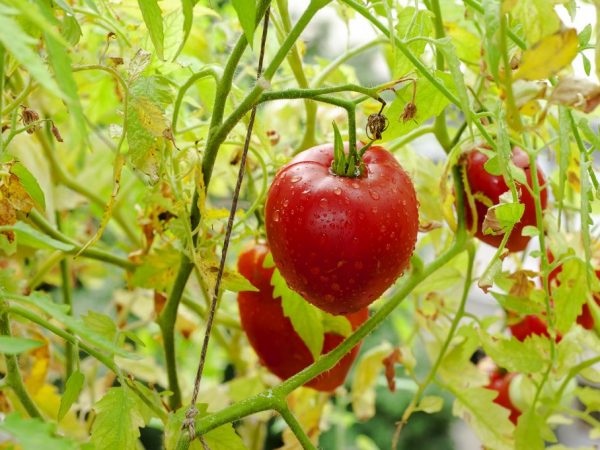

Plants need to be watered regularly
In hot weather, abundant watering is required 2 times a week. If it is not possible to organize it, then the tomatoes grow smaller, but this does not affect the taste of the fruit.
The variety tolerates short-term drought, does not shed flowers in the heat, does not stop fruit setting at high temperatures.
In a greenhouse in cold weather, it is recommended to water through a bottle without a bottom, dug in next to the bush - this method does not increase humidity in the greenhouse and does not provoke the development of rot.
The tomato responds very well to loosening after watering and subsequent mulching.
Top dressing
The variety will show all its declared characteristics with sufficient nutrition. Tomatoes are fertilized 2 times a month, alternating mineral and organic fertilizing.
- Complete complex fertilizer (NPK);
- Ash solution (100 g of ash per bucket of water);
- Azofoska
- Ash solution or infusion of nettle;
- Potassium phosphorus fertilizer (nitrogen must be excluded!)
- Superphosphate (including on the sheet).
():
The superphosphate extract on the leaf is used at the end of summer for a more amicable ripening of fruits. This technique in its action resembles desiccation - drying the leaves. In this case, all the nutrients from the plant are sent to the ripening fruits.
Stepping
Big Mom grows into a powerful, strong bush with potato-type leaves. To avoid thickening when setting the fruit, remove the lower leaves.
She practically does not form stepchildren. It is better to keep the plant in 2 stems, although the tomato itself can bifurcate the shoot. The bush may end, so you should not restrict its growth upward by pinching the crown.
():
All determinant cultivars end their growth on their own, forming the last flower cluster. They don't need edging.
Garter
Big Mom belongs to large-fruited varieties, the brushes and stems of which can break under the weight of the fruit, so the bush must be tied up.
The nuances of growing in an open field and a greenhouse
Summer residents note that in regions with a cold, cool climate, tomatoes will not give a high yield when grown outdoors. Without shelter, they are grown only in the southern regions.
In greenhouse conditions, the bush is formed in 1 main and 1-2 stepson, in open beds in 1 main and 1 stepson.
In greenhouses, tomatoes are watered only in the morning. The shelters are ventilated, avoiding an increase in humidity of more than 80%. At a higher rate, the pollen in the inflorescences sticks together and the plants are not pollinated.
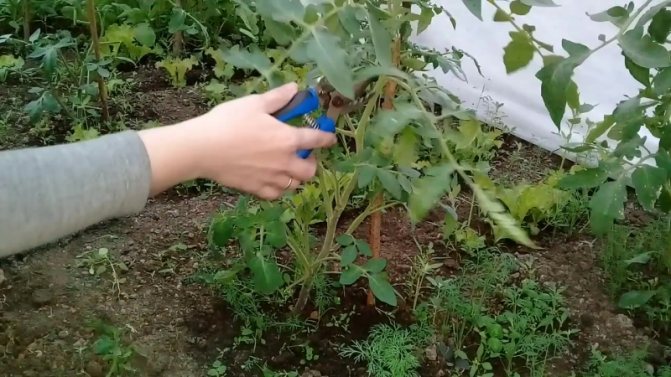

Growing errors
For all its resistance to diseases, the tomato, albeit to a lesser extent, is prone to rot, viral and fungal diseases. Gardeners who neglect the prevention of these misfortunes may lose part or all of the crop.
It is necessary to maintain low humidity in the greenhouse, arrange regular ventilation, remove diseased plants, apply insecticides and phytoncides at the first signs of damage to the bushes.
():
The optimum moisture content for tomato is in the range of 45-60%.
Harvesting and application of the crop
Tomatoes ripen together 85-90 days after germination. The weight of the fruits varies from the bottom to the top of the bush: the lower ones are up to 400 g, the upper ones - 150-200 g.
They are consumed fresh: salads, sandwiches. The variety is suitable for making juices, purees, sauces and snacks. Small fruits can be preserved whole. The dense skin prevents the tomatoes from cracking, making them suitable for transport. Keeping quality is high; according to farmers' reviews, the fruits are stored until late autumn.
Important! Plucked unripe, tomatoes reach in a few weeks in a dark, dry place.
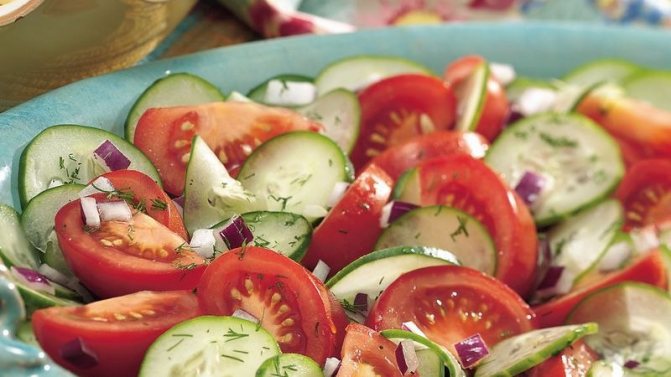

Fruit characteristics
The fruits are dome-shaped with a pronounced spout. There is no pronounced ribbing, it is barely visible. Sometimes tomatoes take on a rounded shape.
Fruit weight can be up to 400-500 grams. Tomatoes are especially good with a thin skin, which is appreciated by lovers of fresh salads.
Interesting! Even ripe fruits with thin skin do not lose their shape during transportation.
The color of ripe tomatoes is bright red, unripe tomatoes are usually green or brownish. The fruits taste great and aroma.
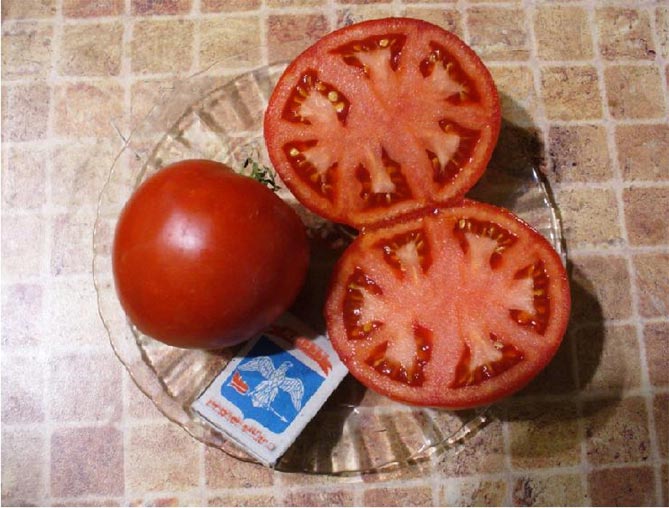

Advantages and disadvantages of the variety
Among the advantages of the variety are called:
- yield - up to 9 kg per square meter;
- the weight of one tomato is 300 g;
- the taste is sweet, with a pleasant tomato sourness;
- early ripening of fruits;
- the ability to endure long-term storage and transportation;
- immunity to diseases and pests;
- the ability to collect seed.
The disadvantages include the impossibility of growing outdoors in the northern regions of Russia.
How to store and use in cooking
Tomatoes of this variety are considered universal for use in cooking. They are great as part of a salad or as a stand-alone dish, the rich pulp does not allow the pieces to creep apart. Also, vegetables of this variety are very good for any preparations - juices, tomato paste, sauces and any other products.
The only problem that may arise during conservation is the very large size, the fruits simply do not fit in jars. You can solve it if you collect fruits that grow below for conservation.
Also, Big Mom is popular with entrepreneurs. The fruits lie very well - if they are collected a little unripe, then Big Mom can be stored twice as much as tomatoes usually lie. There is one trick here - store fruits, and not only tomatoes, any fruits, only in special boxes or in bags made of natural materials. Plastic bags exclude air circulation, so any food in them deteriorates much faster.
Farmers reviews
Gardeners choose a tomato Big Mommy for unpretentious care, immunity to fungal diseases, taste and yield.
Elena, Novoaleksandrovsk, Stavropol Territory: “Last summer we tried to plant a new tomato variety Big Mom. We liked it. We planted bushes both under cover and in the garden. In the greenhouse, the fruits ripened a week earlier. The tomato showed its valuable qualities: early, large, well tolerated transportation. We will plant! "
Alexander, Volgograd region: “The variety has shown itself excellently in the garden. A garter is required, the fruits are weighty. Loves watering. The outer row remained not always well-watered, the difference in the size of the tomatoes is visible. I always keep the stem without lower leaves, insects or infections do not bother me. I did prophylaxis with low-fat milk every week, especially after the rains. "
Ruslan, Tula: “I have my own agricultural company and a year ago the technologists suggested planting this variety as a test one. This year, the number of bushes has been increased - tomatoes are stored well, they are quickly sold out - customers like the taste and appearance. Transportation is well tolerated, we are harvesting a little unripe - so storage can be extended for another two weeks. "
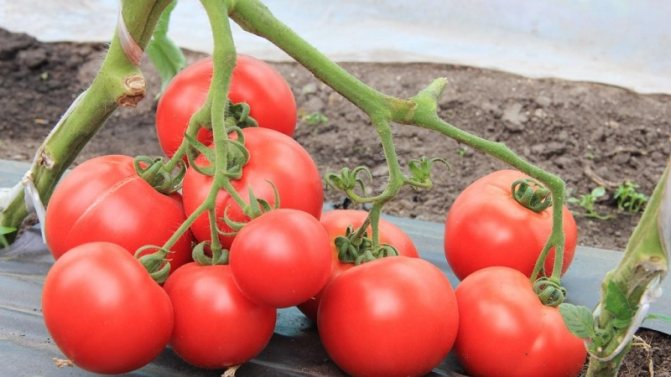

Tomatoes Big Mom on video
If you grew Big Mom tomatoes, please write whether you like them or not. What was the yield and taste of the fruit in your climatic conditions? How do you rate the disease resistance of this tomato? Briefly describe the advantages and disadvantages of the variety in your opinion. If possible, attach a photo of the entire bush or individual fruits grown by you to the commentary. Thank you!
Your reviews about the Big Mom tomato and additions to the description will help many gardeners evaluate this variety more objectively and decide whether to plant it or not.
This is a natural tomato variety. Therefore, we recommend taking seeds from a ripe fruit and using them for planting in the following seasons.
Buy tomato seeds Cornabel
Russia Gardens
Hit of the season 2020! A novelty that has shown a stunning result! High yield! Great fruit taste!


